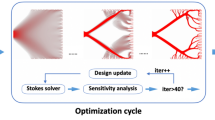Abstract
We present a Graphics Processing Unit (GPU) implementation of the level set method for topology optimization. The solution of three-dimensional topology optimization problems with millions of elements becomes computationally tractable with this GPU implementation and NVIDIA supercomputer-grade GPUs. We demonstrate this by solving the inverse homogenization problem for the design of isotropic materials with maximized bulk modulus. We trace the maximum bulk modulus optimization results to very high porosities to demonstrate the detail achievable with a high computational resolution. By utilizing a parallel GPU implementation rather than a sequential CPU implementation, similar increases in tractable computational resolution would be expected for other topology optimization problems.





Similar content being viewed by others
Notes
Here we obtain 3D, macroscopically isotropic analogues of the structures first considered by Vigdergauz (1989).
References
Allaire G, Jouve F, Toader AM (2004) Structural optimization using sensitivity analysis and a level-set method. J Comput Phys 194:363–393
Bendsøe MP, Sigmund O (2004) Topology optimization: theory methods and applications, 2nd edn. Springer, Berlin
Bensoussan A, Lions J, Papanicolaou G (1978) Asymptotic analysis for periodic structures. North-Holland, Amsterdam
Cao TT, Tang K, Mohamed A, Tan TS (2010) Parallel banding algorithm to compute exact distance transform with the GPU. In: Proceedings of the 2010 ACM SIGGRAPH symposium on interactive 3d graphics and games, pp 83–90
Challis VJ (2010) A discrete level-set topology optimization code written in Matlab. Struc Multidisc Optim 41(3):453–464
Challis VJ, Roberts AP, Wilkins AH (2008) Design of three dimensional isotropic microstructures for maximized stiffness and conductivity. Int J Solids Struct 45:4130–4146
Challis VJ, Roberts AP, Grotowski JF, Zhang LC, Sercombe TB (2010) Prototypes for bone implant scaffolds designed via topology optimization and manufactured by solid freeform fabrication. Adv Eng Mater 12(11):1106–1110
Challis VJ, Guest JK, Grotowski JF, Roberts AP (2012) Prototypes for bone implant scaffolds designed via topology optimization and manufactured by solid freeform fabrication. Int J Solids Struct 49:3397–3408
Chen Y, Zhou S, Li Q (2010) Multiobjective topology optimization for finite periodic structures. Comput Struct 88:806–811
Chen Y, Zhou S, Li Q (2011) Microstructure design of biodegradable scaffold and its effect on tissue regeneration. Biomaterials 32:5003–5014
Garboczi EJ (1998) Finite element and finite difference programs for computing the linear electric and elastic properties of digital images of random materials. Tech rep, NISTIR 6269. http://ciks.cbt.nist.gov/garbocz/manual/man.html
Guest JK, Prévost JH (2006) Optimizing multifunctional materials: design of microstructures for maximized stiffness and fluid permeability. Int J Solids Struct 43:7028–7047
Guest JK, Prévost JH, Belytschko T (2004) Achieving minimum length scale in topology optimization using nodal design variables and projection functions. Int J Numer Meth Engng 61(2):238–254
Hashin Z, Shtrikman S (1963) A variational approach to the theory of the elastic behaviour of multiphase materials. J Mech Phys Solids 11:127–140
Hollister SJ (2005) Porous scaffold design for tissue engineering. Nat Mater 4:518–524
Huang X, Zhou S, Xie Y, Li Q (2013) Topology optimization of microstructures of cellular materials and composites for macrostructures. Comput Mater Sci 67(0):397–407
Kirk DB, Hwu WW (2013) Programming massively parallel processors: a hands-on approach, 2nd edn. Elsevier, Amsterdam
Lin CY, Kikuchi N, Hollister SJ (2004) A novel method for biomaterial scaffold internal architecture design to match bone elastic properties with desired porosity. J Biomech 37(5):623–636
Lin CY, Wirtz T, LaMarca F, Hollister SJ (2007) Structural and mechanical evaluations of a topology optimized titanium interbody fusion cage fabricated by selective laser melting process. J Biomed Mater Res A 83A(2):272–279
NVIDIA (2011) Compute command line profiler user guide
NVIDIA (2012a) CUDA C programming guide version 4.2
NVIDIA (2012b) CUDA toolkit 4.2 thrust quick start guide
Sanchez-Palencia E (1980) Non-homogeneous media and vibration theory, lecture notes in physics, vol 127. Springer, Berlin
Sethian JA (1999) Level set methods and fast marching methods: evolving interfaces in computational geometry, fluid mechanics, computer vision and materials science, 2nd edn.Cambridge University Press, Cambridge
Sigmund O (1999) On the optimality of bone microstructure. In: Bendsøe MP, Pedersen P (eds) IUTAM symposium on synthesis in bio solid mechanics. Kluwer, New York, pp 221–234
Sigmund O (2000) A new class of extremal composites. J Mech Phys Solids 48:397–428
Swan CC, Rahmatalla SF (2006) Strategies for computational efficiency in continuum structural topology optimization. In: Pandey M, Xie WC, Xu L (eds) Advances in engineering structures, mechanics & construction, solid mechanics and its applications, vol 140. Springer, pp 673–683
Vigdergauz S (1989) Regular structures with extremal elastic properties. Mech Solids 24(3):57–63
Wadbro E, Berggren M (2009) Megapixel topology optimization on a graphics processing unit. SIAM Rev 51(4):707–721
Wang MY, Wang X, Guo D (2003) A level set method for structural topology optimization. Comput Methods Appl Mech Engrg 192:227–246
Wang SY, Wang MY (2006) A moving superimposed finite element method for structural topology optimization. Int J Numer Methods Eng 65:1892–1922
Weaire D, Fortes MA (1994) Stress and strain in liquid and solid foams. Adv Phys 43(6):685–738
Zhu HX, Knott JF, Mills NJ (1997) Analysis of the elastic properties of open-cell foams with tetrakaidecahedral cells. J Mech Phys Solids 45:319–343
Author information
Authors and Affiliations
Corresponding author
Additional information
This research was supported under the Australian Research Council’s Discovery Projects funding scheme (project number DP110101653). The computational resources used in this work were funded by a Major Equipment and Infrastructure Grant from The University of Queensland. The authors are grateful to C. J. Foster for assistance with the C++ programming and to B. A. Burton for helpful discussions regarding the presentation of timing data.
Rights and permissions
About this article
Cite this article
Challis, V.J., Roberts, A.P. & Grotowski, J.F. High resolution topology optimization using graphics processing units (GPUs). Struct Multidisc Optim 49, 315–325 (2014). https://doi.org/10.1007/s00158-013-0980-z
Received:
Revised:
Accepted:
Published:
Issue Date:
DOI: https://doi.org/10.1007/s00158-013-0980-z




